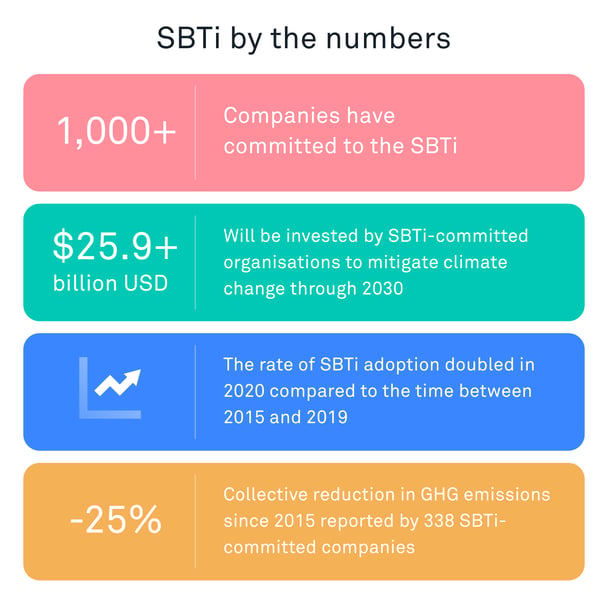What are science-based targets?
The term science-based targets most commonly refers to goals that organisations develop for reducing greenhouse gas emissions.
Setting science-based targets is a key part of ESG (environmental, social, and governance) initiatives, as it takes ESG disclosures one step further — from transparency to action and from reporting to making meaningful change.
What is the Science-Based Targets initiative (SBTi)?
The Science Based Targets initiative, or SBTi, is the result of a joint partnership formed in 2015 between CDP, the United Nations Global Compact (UNGC), World Resources Institute (WRI), and the World Wide Fund for Nature (WWF).
Although other “science-based targets” exist, the term most often refers to this specific program, which is primarily focused on driving down greenhouse gas emissions in line with the goals of the Paris Agreement.
SBTi helps organisations learn how to develop and stick to science-based targets by independently assessing and approving a company’s goals.
The ultimate goal of SBTi is to make science-based targets standard business practice, so that all organisations are involved in mitigating and reducing greenhouse gas emissions. So far, more than 1,000 companies have joined this initiative. And, according to analysis by SBTi, organisations plan to invest more than $25.9 billion USD in climate mitigation aligned with these targets through 2030.
What companies use science-based targets?
The 1,000-plus companies which have set science-based targets include Amazon, Facebook, Best Buy, Ford, Heineken, Puma, Adobe, Lego, Nestle, Johnson & Johnson, IKEA, and Credit Suisse Group (just to name a few).
It’s important to note that not every organisation that opts into SBTi is making the exact same pledge. The initiative allows participants to decide which warming scenario they want to align with. While not all businesses have the capacity to align with the 1.5°C scenario, the discretionary nature could potentially lead capable organisations to needlessly reduce their targets.

Source: Edie
How to set science-based targets
SBTi offers a five-step process for setting science-based targets. Here’s an overview:
- Commit: Submit a letter establishing your intent to set a science-based target, or to have your existing targets independently verified.
- Develop: Work on an emissions reduction target in line with SBTi criteria. Steps for accomplishing this include:
- Determining your organisational and operational boundary and baseline year
- Collecting data on relevant business activities
- Calculating your carbon footprint
- Selecting an SBTi-aligned target setting method
- Setting a target aligned to either a 1.5-degree or 2-degree warming scenario
- Submit: Present your target to SBTi for official validation.
- Communicate: Announce your target and inform your stakeholders.
- Disclose: Report company-wide emissions, including disclosure through CDP, annual reports, sustainability reports, and your company’s website, then track progress toward the target.
SBTi provides robust guidance and resources like commitment letters, case studies, and workshops to minimise as many barriers as possible to the adoption of science-based targets.
They also frequently update their target criteria to meet evolving needs, such as helping companies set targets for more challenging Scope 3 emissions.
Are science-based targets just for greenhouse gases?
Although the science-based targets from SBTi are specifically related to greenhouse gas emissions, businesses can and should set targets for other parts of their ESG policy as well.
Organisations such as Science Based Targets Network are working on developing targets for other areas, such as how to protect and restore nature in line with science.
Science-based target software
Using sustainability software like Rio can help you set, adhere to, and report on science-based targets.
With robust data analysis and ESG governance tools, as well as automated reporting based on leading ESG frameworks, Rio helps businesses stick to their targets and track progress. Rio even tracks the associated carbon footprint of all monitored activity automatically.
You can read more about SBTi and 22 other frameworks, laws, regulations, and indices in our ESG framework guide.

.png?width=2800&height=1400&name=TCFD%20Blog_%20Featured%20Image%20(2).png)









